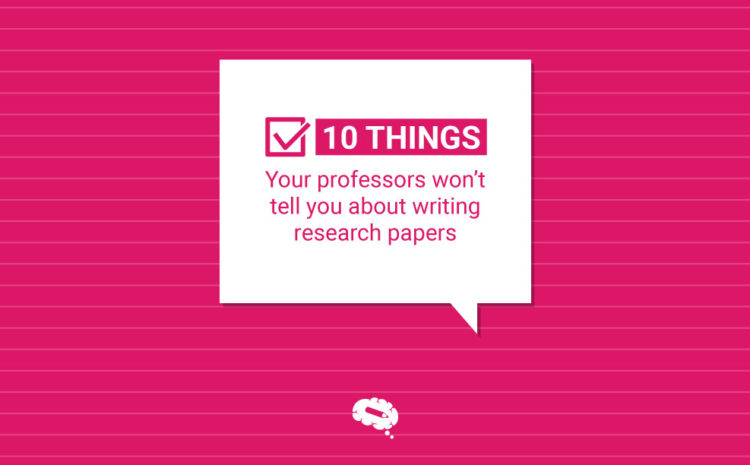A research paper is an essay that explains your opinions and interpretations of a specific topic based on an in-depth exploration of the topic.
Research papers contain information from credible sources such as books, articles, etc, along with your point-of-view about the topic.
The significance of research papers is profound in academics because it goes beyond the boundaries of simply gaining knowledge.
Research papers push you to have an analytical view-point of the topic and think beyond the already existing knowledge on the topic.
According to experts from a popular writing service, Ivory Research, as a student, you must already be aware of the importance of research papers and how these can have a profound impact on your overall grades.
Your professors would have shared some useful tips about writing good research papers.
However, for writing an extraordinary research paper, you need some more actionable insights that will make your paper more unique and interesting.

While professors might provide you with extensive knowledge about the subject at hand, there are some knick-knacks that they would expect you to know, understand, and implement on your own.
This super-informative guide is going to help you with exactly that.
If you are looking for some actionable, effective tips that can enhance the quality of your research papers, this guide is for you. Read on to learn more about some tips that will be super-helpful for you on how to write a research paper.
1. The Introduction is Vital
The introduction of your research paper is definitely important to get right because anyone starting to read your paper is most likely to read the introduction first.
Hence, this is where you should be presenting the topic to the user, along with the definitions, context, and other important information needed to help the reader understand the rest of the paper.

Here are a few tips to get the introduction of your research paper right:
- Right from the first line, your introduction should provide context while engaging the user. Your introduction should sound interesting and useful to the reader in order to keep them glued to your paper till the end.
- Of course, it is important to introduce the topic at hand and some aspects of it that you are going to talk about. Do not go in-depth into any topics. You may also introduce your research paper’s hook or angel here.
- Present your rationale on the topic and what your research is based on. This is important to prove to the reader that you are, after all, presenting something relevant and useful.
- Conclude your introduction with a thesis statement that acts as a transition to the rest of the paper. Ensure that your thesis statement is engaging, to-the-point, and states the significance of the research paper.
2. Stay on Your Central Topic, Always!
While writing a research paper, it is easy to sway from the topic and talk about other things that might not be so relevant to your core idea of the research paper.
Doing this will bring about a lack of cohesion in your paper and confuse the reader about what is the core topic of your research.

To avoid swaying away from the core idea of your research paper, here are some tips that you can follow:
- Always start with an outline, and stick to it. By creating an outline, you decide beforehand what are the things that you are going to be writing about. Hence, you will not end up moving away from the topics that you initially intended to write about.
- Begin with a structure in mind. Think about how you would want to organize the points to be covered and what will be the flow of your paper. This also helps you to stick to the main angel of your research paper.
- Lastly, edit your paper ruthlessly. Leave a gap of at least a day or two between your writing and editing. This will help you look at your paper with a fresh pair of eyes. Go through the paper and remove all those parts where you are swaying away from the core idea of your paper.
- Ensure that your paper is cohesive and has a proper flow to it. Editing, again, helps to ensure that your paper has an appropriate flow to it.
3. Scholarly Writing is Crucial
Unlike other forms of writings, writing a research paper involves a more scholarly approach. Your professors and peers are not looking for witty, conversational forms of writing usually seen in other forms of writing.
Instead, it is important that you present your paper in a way that shows proof of original research, problem-solving, and reflective capabilities.
Scholarly writing involves skillful presentation of the topic, comprehensive literature review, and your methodology and take on the topic, and finally, analysis and findings.
Unfortunately, this is not something that is necessarily taught by professors today, which is why most of the research papers end up looking like essays that simply state the obvious.

4. You Should Have a Say on Your Topic
There is a reason why it is called “research paper” because it involves your original research. Presenting already-known knowledge on a topic is not the point of a research paper.
You must add your take on the topic to your research paper and that is what would make it more interesting to the reader.
Here are a few ways to do that:
- Read more and try to gain extensive knowledge about the topic at hand. While learning, try to understand the different angles using which the information has been presented in existing research papers, online articles, and books.
- Structure and present your analysis and findings in a way that is interesting to the reader. Ensure that you are offering some unique food for thought.
- Personalization is an important factor that distinguishes a winning research paper from the other ones. You need to let the reader know how you are looking at the topic. You should aim to personalize all elements of the research paper including facts, figures, proofs, etc.

5. Create Comprehensive Figures
We all know that presenting anything in a visual format instantly makes it more interesting. The same is the case with research papers as well.
Merely summarizing your analysis and findings in text-based formats may not be clear to the reader.
Adding figures, illustrations, and tables to your research paper is super-important and adds much-needed credibility to it.

- Generously take the help of figures to illustrate your findings. Figures can be in many forms such as graphs, charts, scatter plots, drawings, maps, infographics, and similar more. Go through your research paper and think about all possible places where the text content can be presented in the form of a figure.
- Tools such as Mind the Graph can be extremely beneficial for making graphs online and personalizing your figures in exactly the way you want. You can create ultra-customized graphs, figures, and drawings to enhance your rather plain research paper. Mind the Graph tool is extremely easy to use and consists of the world’s largest scientifically accurate illustrations library that can be helpful for you to get pre made graphs done within minutes.
- If you want to go the extra mile, you may even create a comprehensive, customized infographic that summarizes all your analysis and findings in the best way possible. If this doesn’t impress your readers, nothing else will!
6. Add as Many Concrete Facts as Possible
A research paper can consist of your evaluations, observations, and interpretations of these observations. The literature review that you include in your research paper forms the foundation of your research.
Based on these observations, you should be adding your points of view. Hence, you must get your foundation right.

- This is a no brainer – conduct thorough research of the sources before presenting them in your research paper. Half-baked knowledge can be dangerous. Thus, instead of picking up a line or two from your sources, try to understand the complete context and then add it to your research paper.
- Include a review of facts and citations as a part of your editing process. Chances are, the thing that you got wrong the first time, will become evident to you while editing and proofreading.
7. Have a Top-Down Approach While Writing
A top-down approach is when you start by breaking down a large, main idea into smaller, meaningful sub-parts as we proceed with the research paper.
Such a technique should be applied to writing research papers as it breaks down massive, daunting ideas into smaller, more understandable ideas.

Here are a few steps using which you can follow a top-down approach for writing your research paper:
- Fix your “north star” and base your entire research paper on it. This will provide a clear structure to the reader instead of simply stating random ideas here and there without any cohesion.
- Even if you know the central idea of your paper, it is good to have a bird’s eye view of the entire topic. This will again help you break down your paper into smaller chunks of content.
- As mentioned before, never start writing your research paper without having a detailed outline and structure for your paper. Instead of taking the “come what may” approach, it is better to plan your entire paper in advance and then begin expanding on those ideas gradually as you progress with writing your research paper.
8. Let Others Go-Through Your Research Paper Before You Submit It to The Authorities
Writing a research paper definitely involves the use of technical language and jargon, but the general idea is to make it comprehensible to the general audience as well.

Not everyone interested in reading your paper would have adept knowledge on the subject. Hence, you should ensure that your research paper is understandable by people coming from other industries as well.
While writing your paper, you may not be entirely sure about how others perceive your ideas. Hence it is always helpful to have a fresh set of eyes go through your research paper and provide useful feedback.
This doesn’t mean that you ask your younger brother to read your paper. That won’t work, of course!
You can try to get someone knowledgeable and trustworthy with expertise in your industry to go through your research paper and help you evaluate it from another person’s perspective.
9. More Tangible Proofs Mean Better Grades
To make your research paper’s idea more believable and interesting, it is important to add some real-life examples, use-cases, or explanations to support your claims.
Such elements will add more credibility to your research, make it more intriguing to people pertaining to your industry, and, of course, get you better grades!

- Gather as many tangible proofs as possible to back up your claims and findings. You can do this while doing your research on the topic. Adding these proofs will enable the readers to perceive your research in an entirely different way.
- Real-life case studies and examples related to your topic work like magic. Hence, go the extra mile and don’t give up until you find some kind of proof for your findings.
- The best way to present these explanations is, of course, using some kind of visual content. You can do this by making graphs online and enhancing your explanations by using various forms of illustrations such as bar-graphs, charts, infographics, etc.
10. A Story Works Like a Charm
Stories are the most popular elements that can be added by writers, and research papers are no exceptions. A story adds personality and breathes life into an otherwise not-so-interesting and monotonous research paper.
Moreover, stories have the capability to help people understand complex ideas with ease. Hence, if you are looking for ways to amp up your research paper and do a little extra something, then stories are the way to go!

- Gather any relevant story or narration, either yours or someone else’s, that you may have come across while researching. Ensure that the story is relevant to your research paper topic and adds to the core idea that you want to convey.
- Write the story in a concise, yet compelling manner, such that it hooks in the reader. It is better to state a genuine story instead of a made-up one because the reader will be able to figure it out.
- You may even add the extra oomph to your story by including visuals, illustrations, or infographics that complement your story visually. Pre made graphs would be extremely helpful in creating such illustrative content for the effective narration of your story.
Conclusion
Let’s wrap it up by saying that research papers need not always be boring and monotonous like they are always perceived.
In fact, there are many interesting elements that you can add to your research paper to make it interesting, engaging, and of course for getting better grades. These tips might not necessarily be taught to you by your professors.
But the tips in this article would have definitely helped you get a fair idea on how you can improve the quality of your research paper and present your hours of hard work in the best possible format.
The key is to add your interpretation on the topic, add illustrations and infographics, infuse your creativity, and come up with a masterpiece that justifies the hard work that you put into your research.

Subscribe to our newsletter
Exclusive high quality content about effective visual
communication in science.





